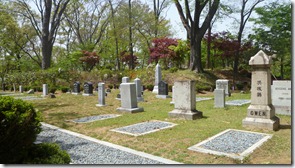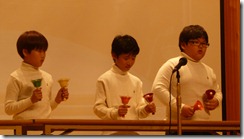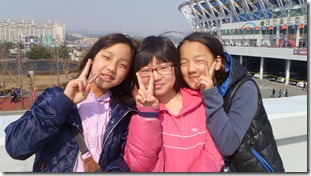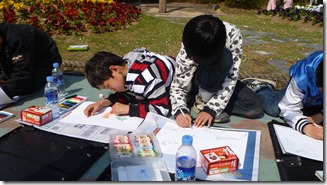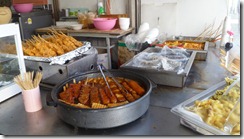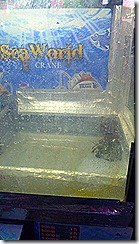Earlier this month, we set aside a day to visit the city of Kwangju, a place where our missionary predecessors flourished. The city has a long tradition of missionaries, who notably founded a hospital, a girl’s school, and a nursing school. We were lucky enough to get tours of these places, and also to visit the mission house (an interesting mixture of Korean and Western architecture) and the missionary graveyard, a beautiful site located on top of a hill.
Kwangju is very significant in recent Korean history because of the democratic movement, culminating in the uprising on May 18th, 1980. In brief: On that day, a protest against the government, mostly by unarmed students, turned disastrous. Paratroopers were ordered to suppress the protest and they did so violently, with the use of clubs and bayonets, eventually even opening fire on the crowd. Not only were many protesters murdered, but innocent bystanders were killed in the crossfire. This led to enraged protesters organizing to fight back, and more than a week of hostilities ensued until the city was retaken by the army on May 27th.
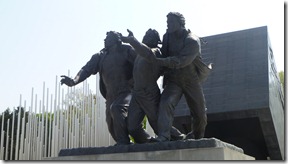 The uprising was in response to the military dictatorship of Jeon Du Hwan, an ROK general who had taken control of the country via a coup in December 1979 (generally), and the May 17th announcement of the expansion of martial law in Korea (specifically). While the uprising did not achieve anything directly – martial law was not lifted, and Jeon remained in power for eight more years – it is nonetheless an important moment for Korean democracy. The courage of the protesters and the people who resisted the government’s brutality were continuing inspirations for the rest of Korea not to give up hope. The response to the massacre also revealed depths of kindness and generosity in people as they reached out to help each other – sharing food, donating blood, and so forth – and to comfort their grieving neighbors. We paid a visit to the memorial park that currently stands in Kwangju in testament to those terrible events, but also to the spirit of resistance that flourished there.
The uprising was in response to the military dictatorship of Jeon Du Hwan, an ROK general who had taken control of the country via a coup in December 1979 (generally), and the May 17th announcement of the expansion of martial law in Korea (specifically). While the uprising did not achieve anything directly – martial law was not lifted, and Jeon remained in power for eight more years – it is nonetheless an important moment for Korean democracy. The courage of the protesters and the people who resisted the government’s brutality were continuing inspirations for the rest of Korea not to give up hope. The response to the massacre also revealed depths of kindness and generosity in people as they reached out to help each other – sharing food, donating blood, and so forth – and to comfort their grieving neighbors. We paid a visit to the memorial park that currently stands in Kwangju in testament to those terrible events, but also to the spirit of resistance that flourished there.
Our other field trip this month was to one of the most significant lines in the world. I never realized that the DMZ was such big tourist business, but apparently it is; 500 tourists come through a day, on average. Mostly they’re foreigners – South Korean residents have to undergo a three-to-six-month background check if they want to visit, presumably so the government can ascertain that they aren’t spies or anything else suspicious like that.
Even so, it’s not the most convenient tourist destination in the world. You have to go through an agency (which isn’t cheap, by the way), you have to sign a release saying that your family won’t sue if you get killed, you get inspected twice by soldiers on the way in, and there are lots o’ rules. To name a few:
- You have to dress properly. No sleeveless shirts, no shorts, no pants with holes, no flip-flops or sandals without backs to them, no national logos, and so on.
- No carrying bags of any kind – anything that could be hiding a bomb or a weapon.
- No pointing, waving, or making other weird hand gestures.
- No cameras with large lenses and no taking pictures, except in a few very limited areas.
These are concerns having to do with security and with the very tense relationship between North and South, but also nobody wants the North Koreans taking pictures that could be used in propaganda. They are constantly watching the South Korean half with binoculars and cameras.
But before we get there, let’s take a step back. That wasn’t our first stop. Before that, we went to Unification Park and 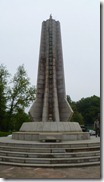 Imjingak Park, which wait on the road north. Unification Park is home to numerous monuments to the heroes of the Korean War, such as the monument honoring journalists who were killed in the conflict; the monument to ten suicide bombers who gave their lives attacking a North Korean camp; and a couple of monuments to individuals who performed acts of incredible bravery. At Imjingak, you can see Freedom Bridge, which was built in a hurry by South Korean soldiers fleeing North Korean forces; a very old train, riddled with over a thousand bullet holes, that was left behind enemy lines after it was attacked; and four statues facing north, who represent South Koreans looking back towards family members they left behind. There are also numerous banners and ribbons demanding peace and unification for the two countries, once one. And there is an altar that serves an important purpose. It’s a Korean tradition (one that originates in Confucianism) to return to one’s hometown and honor one’s ancestors, for example on Chuseok. But after the division into North and South Korea, people with roots in the north could no longer return there. So an altar was built at Imjingak as a place for those people to come instead.
Imjingak Park, which wait on the road north. Unification Park is home to numerous monuments to the heroes of the Korean War, such as the monument honoring journalists who were killed in the conflict; the monument to ten suicide bombers who gave their lives attacking a North Korean camp; and a couple of monuments to individuals who performed acts of incredible bravery. At Imjingak, you can see Freedom Bridge, which was built in a hurry by South Korean soldiers fleeing North Korean forces; a very old train, riddled with over a thousand bullet holes, that was left behind enemy lines after it was attacked; and four statues facing north, who represent South Koreans looking back towards family members they left behind. There are also numerous banners and ribbons demanding peace and unification for the two countries, once one. And there is an altar that serves an important purpose. It’s a Korean tradition (one that originates in Confucianism) to return to one’s hometown and honor one’s ancestors, for example on Chuseok. But after the division into North and South Korea, people with roots in the north could no longer return there. So an altar was built at Imjingak as a place for those people to come instead.
Only afterwards did we continue our journey north, towards Camp Bonifas, the last outpost before the DMZ proper. There we were debriefed and presented with a history of the place before boarding a military bus and heading for the Joint Security Area. This is where diplomatic talks are held under the aegis of the U.N. Originally, the JSA was shared between North and South, and soldiers from both sides could cross the Military Demarcation Line freely within that neutral zone. But after a conflict in the 1970s in which several people were killed, the division became strictly enforced.
The whole area, by the way, is a landmine zone. The roads and the outposts themselves are in areas that have been cleared, but wandering off the paths is inviting one of the tens of thousands of landmines still in the ground to go off under your foot.
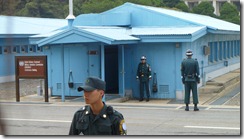 The actual JSA meeting buildings are very small. We were allowed to go into one, where two soldiers were standing guard. Specifically, they have one guy watching the door that opens on the North Korean side. They secure that door during tours, because there have been incidents where the North Koreans have tried to pull people through to the other side. (We only actually saw one North Korean guard, standing across the way watching us through binoculars.)
The actual JSA meeting buildings are very small. We were allowed to go into one, where two soldiers were standing guard. Specifically, they have one guy watching the door that opens on the North Korean side. They secure that door during tours, because there have been incidents where the North Koreans have tried to pull people through to the other side. (We only actually saw one North Korean guard, standing across the way watching us through binoculars.)
As for the guards on the South Korean side, they are chosen from among the elite. They are often black belts in multiple martial arts, know multiple languages, and are tall and imposing-looking. They wear military police helmets and have huge sunglasses so no one can tell where they’re looking. On duty, they stand in a taekwondo ready stance.
As we made our way out of the DMZ, heading back for Camp Bonifas, we stopped briefly at the Bridge of No Return. This was the location of the final POW exchange of the war. When the North Korean prisoners crossed the halfway point on the bridge to return to their own, and the South Korean prisoners did likewise, it marked the last time that people traveled freely between the two countries, once one.
Another tour that is available (although we didn’t do it) is a tour that goes to the third infiltration tunnel. For those of you who don’t know, South Korea has so far discovered four tunnels drilled through the rock under the border, all of a sufficient size to move a lot of troops through them quickly, all well-positioned for an attack on Seoul. The South Korean government has blocked off these four tunnels, but it is believed there may be quite a few more that they have yet to find – possibly up to a total of 17 tunnels in all.
Seeing all of this really brought home to me the wrongness of the situation. I had always known about the Korean War and the division of the country, but seeing a people armed to the teeth against itself is a lot more powerful than reading about it in a history textbook. After all, how frightening is it to draw a line of barbed wire across your country? How horrible is it not to know if your relatives on the other side of the border are alive or dead? And how messed up is it that we accept that as a matter of course these days?
For more pictures of Kwangju, see here. DMZ trip pictures are here.

